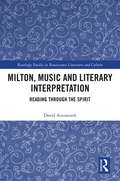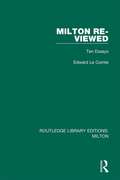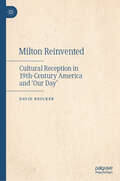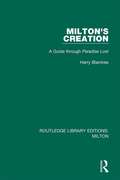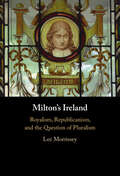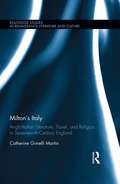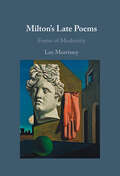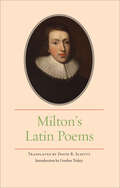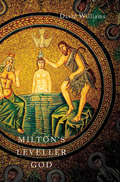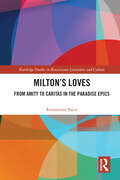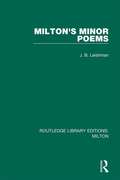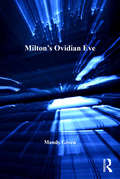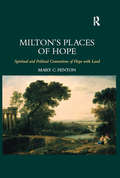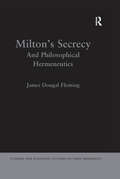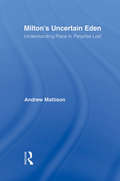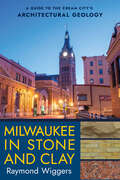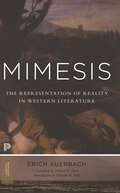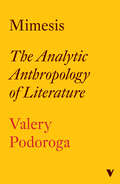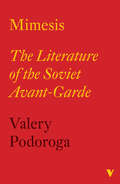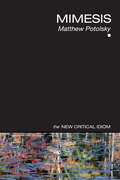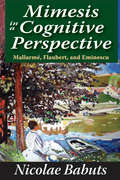- Table View
- List View
Milton, Music and Literary Interpretation: Reading through the Spirit (Routledge Studies in Renaissance Literature and Culture)
by David AinsworthMilton, Music and Literary Interpretation: Reading through the Spirit constructs a musical methodology for interpreting literary text drawn out of John Milton’s poetry and prose. Analyzing the linkage between music and the Holy Spirit in Milton’s work, it focuses on harmony and its relationship to Milton’s theology and interpretative practices. Linking both the Spirit and poetic music to Milton’s understanding of teleology, it argues that Milton uses musical metaphor to capture the inexpressible characteristics of the divine. The book then applies these musical tools of reading to examine the non-trinitarian union between Father, Son, and Spirit in Paradise Lost, argues that Adam and Eve’s argument does not break their concord, and puts forward a reading of Samson Agonistes based upon pity and grace.
Milton Now
by Catharine Gray Erin MurphyBy bringing together Milton specialists with other innovative early modern scholars, the collection aims to embrace and encourage a methodologically adventurous study of Milton's works, analyzing them both in relation to their own moment and their many ensuing contexts.
Milton Re-viewed: Ten Essays (Routledge Library Editions: Milton #5)
by Edward Le ComteFirst published in 1991. These ten essays by the distinguished Milton scholar Edward Le Comte examines the various themes, context and structure of Milton’s poetry and prose, including particular focus on both Paradise Lost and Paradise Regained. This title will be of great interest to students of John Milton and English Literature.
Milton Reinvented: Cultural Reception in 19th-Century America and ‘Our Day’
by David BoockerThis book focuses on the cultural reception of Milton and his works in nineteenth-century America. Using reception theory, the work analyzes the contributions of Milton and his writings to demonstrate how major social movements appropriated him in ways that “reinvent” him, making him what Margaret Fuller called “emphatically American.” The book centers on Milton’s influence on the movements focused on the development of American Christianity, abolition, and women’s suffrage. Each group approaches his writings with different “horizons of expectations” determined, in part, by the social problems they address. Each has unique ways of disseminating and consuming information about Milton and his writings, sometimes determined by how readers in different geographical locations read him. And, each debate makes extensive use of American periodicals of the period, revealing critical information about how Milton’s writings were disseminated and deployed. Milton’s presence in these debates helped shape American society at the time and provides proof for us of how Milton can remain relevant in the issues faced by Americans in ‘our day.’
Milton, Toleration, and Nationhood
by Elizabeth SauerJohn Milton lived at a time when English nationalism became entangled with principles and policies of cultural, religious, and ethnic tolerance. Combining political theory with close readings of key texts, this study examines how Milton's polemical and imaginative prose intersects with representations of English Protestant nationhood. Through detailed case studies of Milton's works, Elizabeth Sauer charts the fluctuating narrative of Milton's literary engagements in relation to social, political, and philosophical themes such as ecclesiology, exclusionism, Irish alterity, natural law, disestablishment, geography, and intermarriage. In so doing, Sauer shows the extent to which nationhood and toleration can be subjected to literary and historicist inquiry. Her study makes a salient contribution to Milton studies and to scholarship on early modern literature and the development of the early nation-state.
Milton's Creation: A Guide through Paradise Lost (Routledge Library Editions: Milton #1)
by Harry BlamiresFirst published in 1971. The intention of Milton’s Creation is to provide the student with a simple and direct entry into Paradise Lost. The author is not concerned with taking sides in critical controversy. His aim is to elucidate Milton’s primary meanings; this is a work of exegesis, not of interpretation. In this new book, on arguably the greatest epic in the English language, the central substance of Milton’s ‘great Argument’ is articulated with great clarity. By keeping in mind the epic status and universality common to Paradise Lost and Ulysses, the author introduces a post-Joycean perspective into his vision of Milton’s Creation.
Milton's Ireland: Royalism, Republicanism, and the Question of Pluralism
by Lee MorrisseyIn this first book devoted to Milton's engagement with Ireland, Lee Morrissey takes an archipelagic approach to his subject. The study focuses on the period before the Cromwellian Conquest, explaining Milton's emergence as a public figure because of Ireland and tracing the paradoxical resonances of Milton's republicanism in Ireland to this day. Informed by developments in Irish history but foregrounding a lucid discussion of Milton's governmental prose works, Morrissey explores the tension between Milton's long-established image as a proto-Enlightenment, democratic figure, and the historical reality of his association with a Protestant invading force. Milton's Ireland incisively negotiates this complex subject, addressing clear absences in Milton scholarship, in the history of Ireland, and in the fraught relationship between Ireland and England.
Milton's Italy: Anglo-Italian Literature, Travel, and Connections in Seventeenth-Century England (Routledge Studies in Renaissance Literature and Culture)
by Catherine MartinThis book joins a growing trend toward transnational literary studies and revives a venerable tradition of Anglo-Italian scholarship centering on John Milton. Correcting misperceptions that have diminished the international dimensions of his life and work, it broadly surveys Milton’s Italianate studies, travels, poetics, politics, and religious convictions. While his debts to Machiavelli and other classical republicans are often noted, few contemporary critics have explored the Italian sources of his anti-papal, anti-episcopal, and anti-formalist religious outlook. Relying on Milton’s own testimony, this book explores its roots in Dante, Petrarch, Ariosto, and that great "Venetian enemy of the pope," Paolo Sarpi, thereby correcting a recent tendency to make native English contexts dominate his development. This tendency is partly due to a mistaken belief that Italy was in steep decline during and after Milton’s travels of 1638-1639, the period immediately before he produced his prose critiques of the English Church, its canon law, and its censorship. Yet these were also fundamentally "Italian" issues that he skillfully adapted to meet contemporary English needs, a practice enabled by his extraordinarily positive experience of the Italian language, cities, academies, and music, the latter of which ultimately influenced Milton’s "operatic" drama, Samson Agonistes. Besides republicanism and theology (radical doctrines of free grace and free will), equally strong influences treated here include Italian Neoplatonism, cosmology, and romance epic. By making these traditions his own, Milton became what John Steadman once described as an "Italianate Englishman" whose classical "literary tastes and critical orientation…were…to a considerable extent" molded by Italian critics (1976), a view that is fully credited and updated here.
Milton's Late Poems: Forms of Modernity
by Lee MorrisseyUpending conventional scholarship on Milton and modernity, Lee Morrissey recasts Paradise Lost, Paradise Regained, and Samson Agonistes as narrating three alternative responses to a world in upheaval: adjustment, avoidance and antagonism. Through incisive engagement with narrative, form, and genre, Morrissey shows how each work, considered specifically as a fiction, grapples with the vicissitudes of a modern world characterised more by paradoxes, ambiguities, subversions and shifting temporalities than by any rigid historical periodization. The interpretations made possible by this book are as invaluable as they are counterintuitive, opening new definitions and stimulating avenues of research for Milton students and specialists, as well as for those working in the broader field of early modern studies. Morrissey invites us to rethink where Milton stands in relation to the greatest products of modernity, and in particular to that most modern of genres, the novel.
Milton's Latin Poems
by David R. SlavittIn this collection, esteemed poet and translator David R. Slavitt brings to life John Milton’s Latin poetry with deft, imaginative modern English translations.While Milton is recognized as one of the most learned English poets in history, his Latin poetry is less well known. Slavitt’s careful rendering brings Milton’s Latin poems—many written in his late teens—into the present. He keeps true to the style of the originals, showing Milton’s maturing poetic voice and the freedom he found working in Latin. On the Gunpowder PlotO, sly Guy Fawkes, you plotted against your king and the British lords, but did you intend to be kindand make up for your malice in this thing with at least a show of piety? Do we findan intention, perhaps, of sending the members of court up to the sky in a chariot made of firethe way Elijah traveled. Or do I distort the simple wickedness of your desire?Featuring an introduction by Gordon Teskey, this comprehensive English-language collection of Milton’s Latin poems pays due respect to a master. Poetry lovers, Milton fans, and scholars of either will welcome, enjoy, and learn from this work.
Milton's Leveller God
by David WilliamsThree and a half centuries after Paradise Lost and Paradise Regain’d were written, do Milton’s epic poems still resonate with contemporary concerns? In Milton’s Leveller God, David Williams advances a progressive and democratic interpretation of Milton’s epics to show they are more relevant than ever. Exploring two blind spots in the critical tradition – the failure to read Milton’s poetry as drama and to recognize his depictions of heaven’s political and social evolution – Williams reads Milton’s “great argument” as a rejection of social hierarchy and of patriarchal government that is more attuned to the radical political thought developed by the Levellers during the English Revolution. He traces echoes between Milton’s texts and thousands of pages of Leveller writings that advocated for popular rule, extended suffrage, and religious tolerance, arguing that Milton’s God is still the unacknowledged ground of popular sovereignty. Williams demonstrates that Milton’s Leveller sympathies, expressed in his early prose, conflicted with his official duties for Oliver Cromwell’s government in the 1650s, but his association with the journalist Marchamont Nedham later freed him to imagine an egalitarian republic. In a work that connects the great epic poet in new ways to the politics of his time and our own, Milton’s Leveller God shows how the political landscape of Milton’s work fundamentally unsettles ancient hierarchies of soul and body, man and woman, reason and will, and ruler and ruled.
Milton's Loves: From Amity to Caritas in the Paradise Epics (Routledge Studies in Renaissance Literature and Culture)
by Rosamund PaiceThis book is about the multiple loves of Paradise Lost and Paradise Regained: sanctioned loves and outlawed loves, sincere loves and false loves, Christian loves, classical loves, humanist loves, and love as emotion. In showing how these loves motivate the most significant actions of the Paradise epics, it reveals Milton to have made creative use of the tensions between philosophical ideals, social conventions, and the rather messier ways in which love emerges in practice. Love, so central to Milton’s view of Edenic joy and obedience to God, unsettles earthly and heavenly communities and is the origin of Miltonic transgression. Milton’s Loves sheds new light on some of the most prominent concerns of Milton scholarship, including why Milton’s God is so difficult for readers to connect to, Satan’s apparent heroism, Milton’s radical theology, and the nature of Milton’s muse. It is a book that will appeal to students and scholars of Milton and early modern studies more broadly and is structured in a way that will aid easy reference.
Milton's Loves: From Amity to Caritas in the Paradise Epics (Routledge Studies in Renaissance Literature and Culture)
by Rosamund PaiceThis book is about the multiple loves of Paradise Lost and Paradise Regained: sanctioned loves and outlawed loves, sincere loves and false loves, Christian loves, classical loves, humanist loves, and love as emotion. In showing how these loves motivate the most significant actions of the Paradise epics, it reveals Milton to have made creative use of the tensions between philosophical ideals, social conventions, and the rather messier ways in which love emerges in practice. Love, so central to Milton’s view of Edenic joy and obedience to God, unsettles earthly and heavenly communities and is the origin of Miltonic transgression. Milton’s Loves sheds new light on some of the most prominent concerns of Milton scholarship, including why Milton’s God is so difficult for readers to connect to, Satan’s apparent heroism, Milton’s radical theology, and the nature of Milton’s muse. It is a book that will appeal to students and scholars of Milton and early modern studies more broadly and is structured in a way that will aid easy reference.
Milton's Minor Poems (Routledge Library Editions: Milton #6)
by J. B. LeishmanFirst published in 1969. These nine lectures written by the distinguished scholar J. B. Leishman examines the various themes, context and structure of Milton’s poetry, with particular focus on L’Allegro, Il Penseroso and Lycidas. This title will be of great interest to students of John Milton and English Literature.
Milton's Ovidian Eve
by Mandy GreenMilton's Ovidian Eve presents a fresh and thorough exploration of the classical allusions central to understanding Paradise Lost and to understanding Eve, one of Milton's most complex characters. Mandy Green demonstrates how Milton appropriates narrative structures, verbal echoes, and literary strategies from the Metamorphoses to create a subtle and evolving portrait of Eve. Each chapter examines a different aspect of Eve's mythological figurations. Green traces Eve's development through multiple critical lenses, influenced by theological, ecocritical, and feminist readings. Her analysis is gracefully situated between existing Milton scholarship and close textual readings, and is supported by learned references to seventeenth-century writing about women, the allegorical tradition of Ovidian commentary, hexameral literature, theological contexts and biblical iconography. This detailed scholarly treatment of Eve simultaneously illuminates our understanding of the character, establishes Milton's reading of Ovid as central to his poetic success, and provides a candid synthesis and reconciliation of earlier interpretations.
Milton's Places of Hope: Spiritual and Political Connections of Hope with Land
by Mary C. FentonIn early modern culture and in Milton's poetry and prose, this book argues, the concept of hope is intrinsically connected with place and land. Mary Fenton analyzes how Milton sees hope as bound both to the spiritual and the material, the internal self and the external world. Hope, as Fenton demonstrates, comes from commitment to literal places such as the land, ideological places such as the "nation," and sacred, interior places such as the human soul. Drawing on an array of materials from the seventeenth century, including emblems, legal treatises, political pamphlets, and prayer manuals, Fenton sheds light on Milton's ideas about personal and national identity and where people should place their sense of power and responsibility; Milton's politics and where he thought the English nation was and where it should be heading; and finally, Milton's theology and how individuals relate to God.
Milton's Secrecy: And Philosophical Hermeneutics (Literary and Scientific Cultures of Early Modernity)
by James Dougal FlemingScientific modernity treats interpretation as a matter of discovery. Discovery, however, may not be all that matters about interpretation. In Milton's Secrecy, J. D. Fleming argues that the poetry and prose of John Milton (1608-1674) are about the presentation of a radically different hermeneutic model. This is based on openness within language, rather than on secrets within the world. Milton's representations of meaning are exoteric, not esoteric; recognitive, not inventive. Milton's Secrecy places its titular subject in opposition to the epistemology of modern natural science, and to the interpretative assumptions that science supports. At the same time, the book places Milton within early modern contexts of interpretation and knowledge. Drawing on Renaissance Neoplatonism, Tudor-Stuart ideology, and the Calvinist theory of conscience, Milton's Secrecy argues that the attempt to theorize interpretation without discovery is not unorthodox within early modern English culture. If anything, Milton's hostility to secrecy and discovery aligns him with his culture's ethical and hermeneutic ideal. Milton's Secrecy provides an historical framework for considering the theoretical validity of this ideal, by aligning it with the philosophical hermeneutics of Hans-Georg Gadamer.
Milton's Uncertain Eden: Understanding Place in Paradise Lost (Studies in Major Literary Authors)
by Andrew MattisonThis study describes a variety of ways of thinking about place in the Renaissance and in Paradise Lost. Despite coming from different perspectives, they have in common the idea that the difficulty of the relationship of reciprocity that poetic subjects often expect from their environment destabilizes those subjects’ understanding, not only of environment, but of themselves. The study explores destabilization as it affects aspects of the poem from Adam’s sense of the landscape of Eden and the meaning of the Fall itself, to the relationship the ambiguous landscapes of Paradise Lost create between Adam and Eve, the poet and the reader; all of whom are struggling to make sense of the same problematically described places. To a surprisingly large extent, the description of prelapsarian Eden and the events that go on within it have in common a failed attempt to understand the nature of the surroundings. In observing the centrality and difficultly of this poetic discourse of place, the problem of place is found at the very heart of the Fall.
Milton’s Visual Imagination
by Stephen B. DobranskiCritics have traditionally found fault with the descriptions and images in John Milton's poetry and thought of him as an author who wrote for the ear more than the eye. In Milton's Visual Imagination, Stephen B. Dobranski proposes that, on the contrary, Milton enriches his biblical source text with acute and sometimes astonishing visual details. He contends that Milton's imagery - traditionally disparaged by critics - advances the epic's narrative while expressing the author's heterodox beliefs. In particular, Milton exploits the meaning of objects and gestures to overcome the inherent difficulty of his subject and to accommodate seventeenth-century readers. Bringing together Milton's material philosophy with an analysis of both his poetic tradition and cultural circumstances, this book is a major contribution to our understanding of early modern visual culture as well as of Milton's epic.
Milwaukee in Stone and Clay: A Guide to the Cream City's Architectural Geology
by Raymond WiggersMilwaukee in Stone and Clay follows directly in the footsteps of Raymond Wiggers's previous award-winning book, Chicago in Stone and Clay. It offers a wide-ranging look at the fascinating geology found in the building materials of Milwaukee County's architectural landmarks. And it reveals the intriguing and often surprising links between science, art, and engineering. Laid out in two main sections, the book first introduces the reader to the fundamentals of Milwaukee's geology and its amazing prehuman history, then provides a site-by-site tour guide. Written in an engaging, informal style, this work presents the first in-depth exploration of the interplay among the region's most architecturally significant sites, the materials they're made of, and the sediments and bedrock they're anchored in. Raymond Wiggers crafted Milwaukee in Stone and Clay as an informative and exciting overview of this city. His two decades of experience leading architectural-geology tours have demonstrated the popularity of this approach and the subject matter.
Mimesis: The Representation of Reality in Western Literature - New and Expanded Edition (Princeton Classics #1)
by Erich Auerbach Edward W. SaidThe classic book that has taught generations how to read Western literatureMore than half a century after its translation into English, Erich Auerbach&’s Mimesis remains a masterpiece of literary criticism. A brilliant display of erudition, wit, and wisdom, his exploration of how great European writers from Homer to Virginia Woolf depict reality has taught generations how to read Western literature.A German Jew who was forced out of his professorship at the University of Marburg in 1935, Auerbach left for Turkey, where he taught in Istanbul. There he wrote Mimesis, publishing it in German after the war. Displaced as he was, Auerbach produced a work of great erudition that contains no footnotes, basing his arguments instead on searching, illuminating readings of key passages from his primary texts. His aim was to show how, from antiquity to modernity, literature progresses toward ever more naturalistic and democratic forms of representation. Ranging over works in Greek, Latin, Spanish, French, Italian, German, and English, Auerbach uses his remarkable skills in philology and comparative literature to present an optimistic view of Western history and culture and to refute any narrow form of nationalism or chauvinism.This expanded Princeton Classics edition of Mimesis includes a substantial introduction by Edward Said as well as an essay in which Auerbach responds to his critics.
Mimesis: The Analytic Anthropology of Literature
by Valery PodorogaGround-breaking work of philosophy and Russian Literature: translated for the first timeValery Podoroga was one of the most important thinkers of his generation. Here his most famous work is translated into English for the first time. In it he gives a panorama view of Russian writing, focusing in on the work of Nikolai Gogol, Fyodor Dostoevsky and Andrei Bely. He identifies these authors as pioneers in creating an 'other literature'. This constituted a new form of mimesis or vision of the world, in opposition to the Imperial and national myths.In Mimesis Podoroga develops and elaborates his analytic anthropological approach on these authors with startling effect, excavating the identities and forms of Russian literature, and society. He places an emphasis on how a literary work is a process of world building: both internally by creating a fictive world, but also how it reflects the wider world in which it was produced, and the power with which it changes the world. Finally, the literary work&’s ability to exist in a time that is other than its own time, a time where it does not have a contemporary reader and an author who exercises his will, but where it nonetheless continues to mean something.Mimesis is rightly seen as the masterwork of one of the world's leading literary thinkers.
Mimesis: The Literature of the Soviet Avant-garde
by Valery PodorogaThe politics of literature in the construction of worldsThe Russian Revolution was a literary as well as political upheaval. With a focus on the revolutionary works of Andrei Platonov and the futurist collective Oberiu, leading Russian literary thinker Valery Podoroga shows how profoundly the Soviet experiment overturned the traditional expectations of fiction and poetry. The production of this groundbreaking new work was inextricably interwoven with the political and historical debates of the time.This volume expands on Podoroga&’s critical exploration of the analytic anthropology of literature. Here he delves into the ways literature can be used in &‘world-building&’, both in terms of what happens inside the narrative and how it reflects the external world. He explores the function of the work outside of its time: both as a means to project itself into the future and as a document of a former age. How are we to read the past through these works of the imagination?With an introductory essay from the author&’s daughter, Ioulia Podoroga.
Mimesis (The New Critical Idiom)
by Matthew PotolskyA topic that has become increasingly central to the study of art, performance and literature, the term mimesis has long been used to refer to the relationship between an image and its ‘real’ original. However, recent theorists have extended the concept, highlighting new perspectives on key concerns, such as the nature of identity. Matt Potolsky presents a clear introduction to this potentially daunting concept, examining: the foundations of mimetic theory in ancient philosophy, from Plato to Aristotle three key versions of mimesis: imitatio or rhetorical imitation, theatre and theatricality, and artistic realism the position of mimesis in modern theories of identity and culture, through theorists such as Freud, Lacan, Girard and Baudrillard the possible future of mimetic theory in the concept of ‘memes’, which connects evolutionary biology and theories of cultural reproduction. A multidisciplinary study of a term rapidly returning to the forefront of contemporary theory, Mimesis is a welcome guide for readers in such fields as literature, performance and cultural studies.
Mimesis in a Cognitive Perspective: Mallarme, Flaubert, and Eminescu
by Nicolae BabutsMimesis is a critical and philosophical term going back to Aristotle. It carries a wide range of meanings, including imitation, representation, mimicry, the act of expression, and the presentation of self. In modern literary criticism, mimesis has received renewed attention in the last two or three decades and been subject to wide-ranging interpretations. Nicolae Babuts looks at the concept of mimesis from a cognitive perspective. He identifies two main strands: the mimetic relation of art and poetry to the world, defined in terms of reference to an external reality, and the importance of memory in the making of plots or storytelling.Babuts suggests that there is a material identity we cannot know beyond the limits of our senses and intellect and a symbolic or coded identity that is processed by memory. All writers, including Mallarme in his esoteric poetry, Flaubert in his realist narratives, and Mihai Eminescu, the Romanian poet, in his romantic poems, rely on mimetic strategies to link the two identities: the images in memory to the outside reality. All order their narratives in accordance with the dynamics of memory. Babuts describes this phenomenon with great insight, showing how new traditions are formed.
